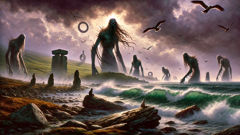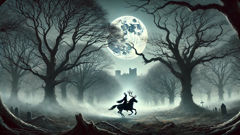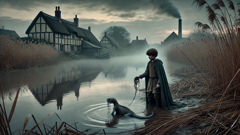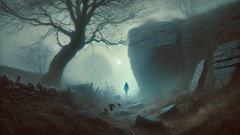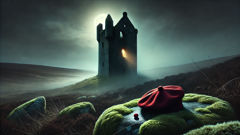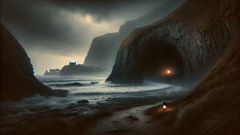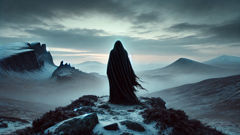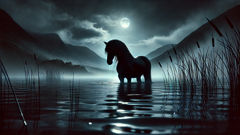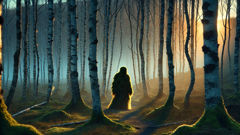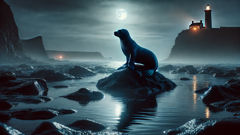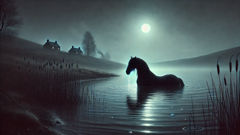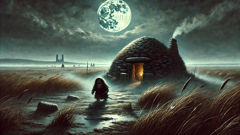Introduction
Mist lingers on the rocky shores of ancient Ireland, curling through craggy inlets where the Atlantic pounds the land with ceaseless force. The air carries the scent of seaweed and peat, mingling with the echo of legends whispered through countless generations. Before the land was called Éire, before saints and kings carved their marks into its green heart, the island was a canvas for primal forces. In those days, monsters roamed the wild, magic bled from the soil, and the destinies of mortals and immortals clashed beneath storm-churned skies. Among the most enduring tales from these shadowed ages is the legend of the Formorians—a race neither wholly human nor beast, born from sea and darkness, whose very presence threatened to consume Ireland in perpetual night. Ancient bards spoke of their warped forms and baleful eyes, describing them as giants with twisted limbs, as cyclopean lords with a hunger for dominion, as specters who haunted the boundary between the living world and the realms of chaos. But their story is more than a catalogue of horrors—it’s a saga of ambition and resistance, of battles waged beneath blackened clouds, of a land and its people forging identity in defiance of shadow. This is the chronicle of how the Formorians came to Ireland, how they ruled with terror and cunning, and how they met their match in the Tuatha De Danann, the shining folk whose magic rivaled even the oldest gods. Through storm and sorrow, hope and heroism, the legend of the Formorians is woven into the very fabric of Ireland—etched in standing stones, sung at firesides, and remembered in the bones of the land itself.
The Arrival of Shadows: Origins of the Formorians
Long before the first cattle grazed in Irish meadows, before the druids raised their sacred groves, the world was a churning sea of possibility. It’s said that out of the primal depths, when chaos still clung to the land, the first Formorians arose—spawned from sea foam, storm, and the shadow between worlds. Some called them children of Domnu, the primordial mother of the deep, whose embrace was cold and fathomless. Others whispered that they were born of the world’s wounds: where earth met water in violence, they crawled forth, misshapen and hungry.
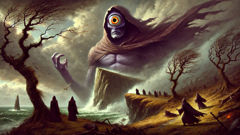
The earliest tales describe the Formorians as an ever-shifting people. Some were giants with limbs as thick as ancient oaks, eyes burning like coals beneath their heavy brows. Others were twisted and monstrous, with goat-hooves or single baleful eyes, their flesh mottled like the stones of tidal pools. They carried with them an aura of otherness—the sense that they belonged not to the land but to a deeper, darker place. Their language was guttural, their laughter cold, and wherever they walked, the wind seemed to die and the earth to sour beneath their feet.
Their first landings were marked by violence. The Formorians swept onto the shores of Ireland in crude vessels, sails tattered and black as midnight. Led by Balor of the Evil Eye—giant among giants, whose single gaze could wither crops and shatter stone—they claimed rocky promontories and wind-battered islands as their own. The local tribes, few and scattered, could not stand before them. From their fortresses on Tory Island and the bluffs of Donegal, the Formorians demanded tribute: gold, cattle, and above all, the first fruits of every harvest.
Their rule brought blight and terror. Each year, as the crops began to ripen, black ships would appear on the horizon. Formorian envoys, cloaked and masked, would come to demand their due. Woe to any who resisted—for Balor’s wrath was legendary. With every refusal, storms lashed the coasts, plagues swept through villages, and strange creatures crept from the bogs. The people lived in constant dread, knowing that a single misstep could invite disaster upon their heads.
Yet the Formorians were not mindless brutes. Their chieftains were cunning, skilled in dark sorceries learned in the depths of the world. Their seers could summon fog to hide their armies, or call forth nightmares to torment their enemies in sleep. They bartered with ancient spirits, forged alliances with the restless dead, and shaped the land to their will. Under their rule, Ireland became a place of fear—a twilight realm where nothing was certain and every shadow might conceal a lurking threat.
Still, not all hope was lost. Even in those dark days, resistance simmered. Secret bands of warriors trained in hidden glens, plotting rebellion. Wise women kept the old fires burning, preserving charms and songs that might one day break the Formorian curse. Far to the east, across the sea, new powers were stirring—powers that would soon change the fate of Ireland forever.
The Tuatha De Danann: Shining Foes and Sacred Magic
While the Formorians tightened their grip on Ireland, a new force gathered strength beyond the horizon. The Tuatha De Danann—People of the Goddess Danu—sailed from distant lands shrouded in mist and memory. Legends tell that they arrived in a fleet of silver ships, veiled by clouds and song, bearing treasures and knowledge unknown to mortals. With them came four sacred relics: the Stone of Destiny, the Spear of Lugh, the Sword of Nuada, and the Cauldron of Dagda—each brimming with power that could shape the fate of the world.
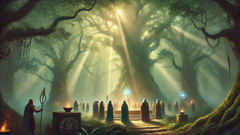
The Tuatha were tall and fair, ageless as starlight, their eyes alight with wisdom and secrets. They were masters of sorcery and craft—wielding magic with a gentler touch than the Formorians’ dark arts, yet no less potent. They built their halls in the heart of ancient forests and upon high hills, setting standing stones to mark their sacred places. Under their guidance, the land seemed to breathe anew: rivers ran clear, forests flourished, and hope returned to the hearts of the people.
Yet peace was not easy. The Formorians saw these newcomers as a threat—and rightly so. For the Tuatha De Danann were not mere wanderers; they had come to claim Ireland as their own, to overthrow the old oppressors and restore balance. Their king, Nuada of the Silver Hand, sent envoys to parley with the Formorians, but mistrust ran deep. Balor’s court was a nest of intrigue and suspicion, where every word was weighed for hidden meaning, every gesture a potential betrayal.
It was Lugh—warrior, craftsman, and trickster—who would become the hero of this conflict. Born of both Tuatha and Formorian blood, Lugh was a bridge between worlds: grandson of Balor himself, yet raised among the shining folk. His skills were legendary; his mastery of every art and weapon inspired both awe and fear. When he arrived at Nuada’s hall, he was challenged to prove his worth. With each trial, he demonstrated knowledge and strength beyond any before him, earning his place among the Tuatha’s greatest champions.
Tensions grew as omens darkened. Crops failed, storms battered the coast, and rumors of Formorian armies gathering in secret reached the Tuatha’s spies. The druids read portents in the stars and saw a future thick with blood. It was clear: there could be no peace while the Formorians ruled from their iron towers. The Tuatha De Danann began to prepare for war—not just for control of the land, but for its very soul.
Both sides called upon powers beyond mortal ken. The Formorians deepened their ties to chaos, summoning monsters and raising armies of twisted creatures from bogs and caves. The Tuatha De Danann forged alliances with spirits of river and tree, drawing upon the ancient wellsprings of Ireland’s magic. As summer waned and the shadow of winter stretched across the land, all knew that a reckoning was at hand.
The Battle for Ireland: Cath Maige Tuired
As autumn’s breath chilled the fields and mist thickened in the valleys, Ireland braced itself for war. The armies of the Formorians gathered in the north and west: ranks of giants clad in patchwork armor, monstrous beasts leashed to iron chariots, and sorcerers muttering curses as they painted their faces with ash. From every outcrop and island came Balor’s kin—mighty Conann, ferocious Indech, sly Elatha. The air grew heavy with omens.
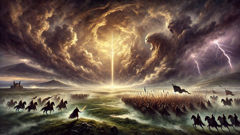
Opposing them, the Tuatha De Danann assembled beneath the shadowed hills of Connacht. Their banners shimmered in the gray light, woven with sigils of power and hope. Nuada led his warriors with quiet resolve, his silver hand glinting at the hilt of his sword. Lugh moved among them, whispering encouragement, forging weapons, and planning strategy with the wisdom of both a god and a mortal. The druids kindled sacred fires and invoked blessings from the land itself.
The night before battle, thunder rolled across the hills. Both armies made ready: the Formorians chanting beneath the moon, Tuatha warriors polishing blades by firelight. Tales say that all the spirits of Ireland watched that night—the old gods leaning in to witness the fate of their favorite isle.
At dawn, the armies met at Maige Tuired—the Plain of Towers. The ground shook with every footfall as giants clashed with champions. Formorian sorcerers unleashed plagues of locusts and black fogs; Tuatha druids countered with shields of light and whispers that calmed the wind. Balor, towering above all, strode forward with his deadly eye covered by seven iron shields. Each time he uncovered it, devastation swept the field—warriors fell to dust, trees burst into flame, even stone seemed to melt.
But Lugh, destined to change the tide, knew his grandfather’s weakness. With cunning and courage, he maneuvered through chaos to face Balor. As Balor’s eye was bared, Lugh unleashed a spear forged from lightning itself, striking his foe with such force that the eye burst from its socket and blazed through the Formorian ranks—turning their terror against them. Balor fell, thunder echoing across the plain.
With their king defeated, the Formorians faltered. The Tuatha pressed their advantage, breaking enemy lines and driving the monsters into retreat. Sorcerers fled into the mists, giants collapsed beneath volleys of enchanted arrows, and the last of Balor’s kin vanished into sea and shadow.
When the battle ended, Ireland lay battered but free. The Formorian threat was broken—for now—but scars remained. The land would never forget the blood spilled at Maige Tuired, nor the courage that had won its dawn.
Conclusion
The legend of the Formorians did not end at Maige Tuired. Though driven from power, remnants of their race lingered in hidden places—haunting windswept headlands, lurking beneath lonely hills, or whispering from ancient bogs when the moon was dark. Some say that their blood mingled with that of mortals, giving rise to lineages marked by wildness or uncanny gifts. Others believe that the Formorians became guardians of forgotten secrets, neither wholly banished nor entirely defeated. For Ireland herself is a land shaped by contrasts: shadow and sunlight, sorrow and song, terror and hope. The legacy of the Formorians endures in every tale told by firelight, in every storm that rattles the stones, in every struggle between darkness and light. As long as stories are spoken on this green island, their memory will never fade—reminding each generation that even the deepest shadow is shaped by the promise of dawn.

